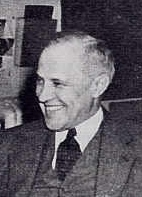Karl Taylor Compton
Karl Compton | |
|---|---|
 | |
| President of the Massachusetts Institute of Technology | |
| In office 1930–1948 | |
| Preceded by | Samuel Wesley Stratton |
| Succeeded by | James Rhyne Killian |
| Personal details | |
| Born | September 14, 1887 |
Karl Taylor Compton (September 14, 1887 – June 22, 1954) was a prominent American physicist and president of the Massachusetts Institute of Technology (MIT) from 1930 to 1948.[1]
The early years (1887–1912)
Karl Taylor Compton was born in
Beginning in 1897, Compton's summers were spent camping at Otsego Lake, Michigan while attending Wooster public schools in fall, winter and summer. He took hard labor jobs starting at age eleven to help pay for college, working carrying hods for construction projects, as a farm hand, mule skinner, a book canvasser, in tile and brick factories and surveyed the first mile of paved road in Ohio.
In 1902, Compton skipped a grade and went into
Reed College and WW I (1913–1918)
In June 1913, Compton married Rowena Raymond. They moved to
Princeton University (1918–1930)
After the
. His paper with OT Richardson, "The Photoelectric Effect," in 1912[7] was one of the first verifications of Einstein's 1905 paper on the photoelectric effect.[8]Rowena died in the fall of 1919. In 1921, Compton married Margaret Hutchinson, with whom he had a daughter, Jean, and a son, Charles Arthur. In 1927, Compton was named director of research at the Palmer Laboratory and Cyrus Fogg Brackett professor. In 1929 he was appointed head of the department. Over one hundred papers were published in his name during his time at Princeton.
In 1923, Compton was elected a member of the
Massachusetts Institute of Technology (1930–1954)
In 1930, Compton accepted an invitation from the
During Compton's service as president, the organization went through a revolutionary change. He developed a new approach to education in science and engineering, the influence of which was felt far beyond MIT. Significantly, he was active in the Society for the Promotion of Engineering Education, and its president in 1938. He was a leader in establishing new standards for the accreditation of engineering criteria through his role as chairman of the Committee on Engineering Schools of the Engineer's Council for Professional Development. He believed in broad-based education for scientists and engineers that was responsive to the needs of the time, and that science should be an element of industrial progress.
In the early 1930s, Compton joined with members of the APS to form the American Institute of Physics (AIP). While he was chairman of the AIP board during 1931–1936, the organization became a federation of several disparate societies for developing subject areas in physics. It sponsored publication of research results in the rapidly expanding study of physics during that era.
In 1948, Compton resigned his post as President of MIT and was elected president of the MIT Corporation. He held that position until his death on June 22, 1954.
Cooperation with the military (1933–1949)
In 1933, U.S. President
In August 1942, Roosevelt appointed Compton to the Rubber Survey Committee, which investigated and made recommendations to help resolve conflicts on technical direction in the development of synthetic rubber, arising due to the loss of rubber supply during the war.[9]
In 1945, Compton was selected as one of eight members of the
Awards and honors
- The Rumford Prize of the American Academy of Arts and Sciences in 1931
- The Presidential Medal for Merit in 1946 for hastening the termination of hostilities by means of the radarresearch and development program he directed.
- The National Academy of Sciences. in 1947 for his eminence in the application of science to the public welfare.[11]
- The Washington Award of the Western Society of Engineers in 1947
- Honorary Commander, Civil Division, of the Most Excellent Order of the British Empirein 1948
- Knight Commander of the Royal Norwegian Order of St. Olavin 1948
- The Lamme Medal of the American Society for Engineering Education in 1949
- The American Institute of Mining and Metallurgical Engineers and the American Society of Civil Engineersin 1950
- The Scientific Research Society of Americain 1950
- Officer in the French Legion of Honorin 1951
- The Priestley Memorial Award of Dickinson College in 1954 for his contributions to the "welfare of mankind through physics" [12]
The lunar crater Compton is named after Compton and his brother Arthur, who was also an influential scientist. Compton was also the recipient of thirty-two honorary degrees.
References
- ^ Borth, Christy. Masters of Mass Production, pp.14-15, Bobbs-Merrill Co., Indianapolis, Indiana, 1945.
- ^ "Karl Taylor Compton | American physicist". Encyclopedia Britannica. Retrieved 2019-09-29.
- ISBN 9780309047463.
- ISBN 9780838910047.
- ISSN 1536-6065.
- .
- ISSN 0036-8075.
- ISBN 0-486-26126-3.
- ^ "U.S. Synthetic Rubber Program". Retrieved 4 Jan 2014.
- ^ Compton, Karl T. (1946-12-01). "If the Atomic Bomb Had Not Been Used". The Atlantic. Retrieved 2024-01-26.
- ^ "Public Welfare Award". National Academy of Sciences. Archived from the original on 4 June 2011. Retrieved 14 February 2011.
- ^ "Joseph Priestley Celebration". Dickinson College. Archived from the original on 7 March 2012. Retrieved 17 February 2011.
Further reading
- Office Of The National Research Council, Biographical Memoirs, National Academies Press, (October 1, 1992), ISBN 0-309-04746-3
- Galison, Peter, and Barton Bernstein. "In any light: Scientists and the decision to build the Superbomb, 1952-1954." Historical Studies in the Physical and Biological Sciences 19.2 (1989): 267–347. online
External links
- Photograph of Karl Taylor Compton and other members of the NDRC Archived 2011-05-14 at the Wayback Machine
- Official MIT Presidential Biography
- Julius A. Stratton's biography of Compton[permanent dead link]
- Annotated bibliography for Karl Compton from the Alsos Digital Library for Nuclear Issues
- National Academy of Sciences Biographical Memoir
